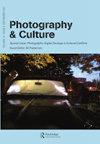The Polymorph
IF 0.3
4区 艺术学
0 ART
引用次数: 1
Abstract
A creature tattered and alone wanders through urban and desolate spaces on earth and above, in search of respite. The Polymorph is a story of belonging, a story that follows a lonely alien, unidentifiable no face to be seen. What does it mean to belong in today’s world? As Franz Kafka described of the character Odorak in Cares of a Family Man, ‘the whole thing looks senseless enough, but in its own way perfectly finished’ (Kafka, 2002, p.77). I am perplexed by the production of narratives, by the definitions of what it means to be useful, what it means to belong, to be human enough to be considered in today’s world? The story of The Polymorph focuses on an imagined creature that replicates the icons and characters regurgitated in an age-old narrative, repeating itself over and over; as if on a carousel with a formula seemingly forever identical searching for home a place to be ‘me’ with ‘you’. Where has the constructed creature come from? The creature is an amalgamation of broken bits of iconography, imagery, mythology, media and so on, found within societies culture, that suggests to us what our sense of power, belonging and identity should look like. The shape that the creature takes is a poorly constructed spaceman. The creature has been created in the image of human betterment, but come closer, you shall see, it is a fragile, tangible, otherly creature composed of earthly materials. Over layered and stuck together, the creature is trapped and alone in this alien body. This isolated creature, The Symbol, finds anOther along his journey The Sibling. The Symbol wanders through landscapes, isolated in the urban, alienated in the barren. Until it sees a figure; It was tall and stood upright like him, as he came closer, he saw the familiar smooth shape of body. The figure turned around and there, in the stranger’s face, The Symbol saw himself. Knowable, visible, graspable, it was the Other, the Sibling. Integral to this work is the notion of the Other, a concept derived from Edward Said’s the Orient. ‘Its origin in a quotation, or a fragment of text ... or some bit of previous imagining’ (Said, 2003, p.177). The Other is not a human, it is part of a simulacra to control individuals and to dehumanise and disempower an individual or group of people. As well as commenting on this aspect of dominant narratives, the Other within The Polymorph, evolves to explore wider philosophical tropes of existing and ideas of self fractured and mirrored, searching for a space to belong to come home to.的变形
一个衣衫褴褛、孤独的生物在城市和荒凉的空间中徘徊,寻找喘息的机会。《变形》是一个关于归属感的故事,讲述了一个孤独的外星人的故事,他无法辨认,连脸都看不见。融入当今世界意味着什么?正如弗朗茨·卡夫卡(Franz Kafka)在《一个顾家男人的烦恼》(Cares of a Family Man)中描述的人物奥多拉克(Odorak),“整件事看起来毫无意义,但以自己的方式完美地完成了”(卡夫卡,2002年,第77页)。我对叙事的产生感到困惑,对什么是有用的定义,什么是归属的定义,什么是在今天的世界中被认为是人类的定义?《变形记》的故事集中在一个想象中的生物身上,它复制了一个古老叙事中反复出现的图标和人物,一遍又一遍地重复;就像在旋转木马上,带着一个似乎永远相同的公式,寻找一个家,一个和你在一起的地方。构造出来的生物是从哪里来的?这个生物是图像、图像、神话、媒体等碎片的混合体,在社会文化中发现,它向我们表明我们的权力感、归属感和身份应该是什么样子。这种生物的形状就像一个构造拙劣的宇航员。这种生物是按照人类的美好形象被创造出来的,但走近一点,你会发现,它是一种脆弱的、有形的、由世俗材料组成的另类生物。这个生物被困在这个外星人的身体里,被层层粘在一起。这个孤立的生物,符号,在旅途中找到了另一个兄弟。符号在景观中游荡,在城市中被孤立,在荒芜中被异化。直到它看到一个人影;它像他一样高大直立,当他走近时,他看到了熟悉的光滑的身体形状。那个身影转过身来,在陌生人的脸上,符号看到了自己。它是可知的,可见的,可把握的,是他者,是同胞。这部作品不可或缺的是他者的概念,这个概念来源于爱德华·赛义德的《东方》。它起源于一句引语或一段文字……或者之前的一些想象”(Said, 2003, p.177)。他者不是人类,它是一个拟像的一部分,用来控制个人,使个人或一群人失去人性和权力。除了对主导叙事的这一方面进行评论外,《变形》中的他者还探索了存在的更广泛的哲学修辞和自我断裂和镜像的想法,寻找一个属于回家的空间。
本文章由计算机程序翻译,如有差异,请以英文原文为准。
求助全文
约1分钟内获得全文
求助全文

 求助内容:
求助内容: 应助结果提醒方式:
应助结果提醒方式:


